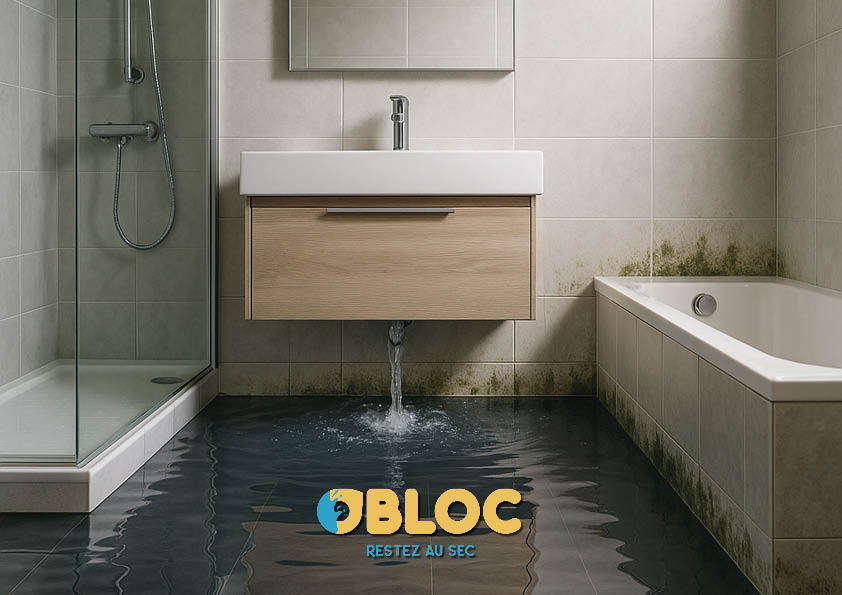At OBLOC®, we know how brutal a flood can be. Whether you live in the city, the countryside, or even the suburbs, no home is immune to a sudden natural phenomenon, whether it's a flooded river, a violent storm, or a simple overflowing stream. A flooded basement , crawl space , or even a flooded terrace can be enough to paralyze a home.
This guide aims to answer the many questions residents ask when faced with a flood warning. What should you do immediately? How can you protect yourself? Who should you contact? What are the best actions to limit the damage? And, above all, how can you combat future flood risks? Our goal is clear: to help you maintain control, both today and tomorrow.
Why might your house flood?
It's not just a flood zone problem
It's often believed that only homes located in a flood zone are affected. However, the reality is quite different. A simple slope, a low basement window, a sunken garage, or a poorly insulated heating system can become the weak points of your home. In some communities, all it takes is a particularly wet time of year or poor pipe maintenance to bring everything down.
Climate change is increasing the frequency of extreme rainfall. A flooded terrace, a flooded garden, or a flooded mattress on a ground floor are becoming increasingly common. In cities, underground parking lots and basements are prime targets. A flooded car or a lost valuable are just as preventable traumas as a poorly controlled bathtub faucet leak .
It is therefore crucial to understand that your home's vulnerability assessment depends not only on the flood zone map. It also depends on the design of your building and the maintenance of your equipment.
What to do immediately in the event of a flood?
5 emergency solutions:
- Turn off the electricity at the main circuit breaker to avoid any risk of electrocution.
- Build your emergency kit.
- Evacuate vulnerable people
- Block access to critical rooms with flood barriers.
- Immediately contact emergency services (112) and your insurer to report the incident.
Warning signs
Even before the water level rises, several indicators can alert you: regularly consult the Vigicrues and Météo-France bulletins, especially when the alert level reaches Orange. Pay attention to small recurring leaks, low cracks in your exterior or interior walls, and rising damp in the ground or crawl space. The appearance of mold or abnormal ambient humidity is also a warning sign that should prompt you to act immediately.
Secure your home and your surroundings
From the first signs of infiltration, safety is the priority. Turn off the power at the main circuit breaker if it's still safe to do so. Then, evacuate the elderly, children, or people with reduced mobility. If the alert is issued by Météo-France, follow the instructions of emergency services and local authorities to the letter. Stay informed via social media, the government website, or directly by contacting your local authority.
Also consider protecting live and dead animals that may be present around your land or cellar: they represent a health risk. Gather your important documents, identity papers, and essential items in a ready-to-go emergency kit, complete with a working flashlight. Protect your well-being and that of those around you by following clear protective measures.
Detailed Emergency Kit
Your emergency kit should be ready at all times, ideally in a waterproof and easily transportable bag. It should contain a battery-powered radio with spare batteries, a supply of drinking water of at least 2 L per person per day, a basic first aid kit including bandages, antiseptic and essential medicines , as well as spare blankets and clothes . Do n't forget to bring external chargers and USB cables , as well as your identity papers and insurance contracts in paper and digital format.
React quickly depending on the affected areas
When faced with a flood, every area of the home must be treated with care. A flooded basement , for example, can quickly become a hotbed of mold if the ambient humidity is not treated. As soon as conditions allow, it is necessary to ventilate as much as possible and evacuate the water using a submersible pump or, failing that, manually. The use of a dehumidifier is then crucial to purify the air and prevent the proliferation of invisible fungi.
A flooded crawl space presents other challenges: difficult to access and often without electricity, it requires a specific approach. Non-current absorbent solutions allow for intervention even in the event of a power outage. It is also important to ensure that this area remains well ventilated for several days after drying out to avoid delayed damage.
A flooded garage is often the first to be affected, especially if it faces a slope or a courtyard. In the event of rapid flooding, it is important to prevent water from reaching adjacent rooms. Flood bags , an inflatable dinghy, or an emergency drainage system can limit the impact. If a vehicle is submerged, it is imperative not to start it without first inspecting it. Likewise, if the heating system or other electrical equipment is in this area, they must be inspected.
Flooded parquet floors , on the other hand, can trap water deep within the floor. Even if they feel dry to the touch, moisture can lodge under the planks and cause warping. Regularly ventilating, removing affected baseboards, and monitoring humidity levels with a hygrometer can prevent lasting damage. In some cases, temporary removal of the flooring is unavoidable.
Finally, basements require special attention. In the event of standing water, you must act quickly to preserve the building's structure. Turning off the power, removing damp items, disinfecting affected areas, and scheduling a vulnerability assessment are all essential steps. These simple actions can help combat the invisible, but very real, consequences of a prolonged disaster.
What to do if water has already entered the house?
Combating damage without making it worse
When water is installed in the home, act methodically. Do not stay in rooms where water reaches outlets or heating systems. If necessary, contact insurance companies, the fire department, or a professional plumber to assess structural flood risks. Have a professional diagnoses performed in case of leaks and prolonged water damage .
Document everything: film, photograph, and note the time and date. Each expert visit will be easier if you have gathered solid evidence. Remember to contact your insurance company within 5 business days. Most insurance companies also require follow-up after a natural disaster order, often issued by the municipality or the Ministry of the Interior.
Who to call in case of a house flood?
Coordination of relief and administrative procedures
Contact emergency services (112) in case of immediate danger, then your insurance company to report the claim within 5 days. working days. Prepare your file with photos, videos , and invoices. For recognition as a natural disaster, follow the procedure via the prefecture . Call on an independent expert (CNCEJ network ) and, if necessary, a plumber- repairer or sanitary craftsman for more targeted diagnostics.
Additionally, some communities organize post-flood cleanup operations in conjunction with town halls or departmental services. It is sometimes possible to arrange an appointment with a public service for a vulnerability assessment or even temporary material assistance.
How to protect yourself from flooding?
Prevention and concrete long-term solutions
After a disaster, protecting your home becomes a priority. Simple actions like raising electrical equipment, checking pipes, or installing a backwater valve can reduce the risk of flooding. A vulnerability assessment can also be useful, especially in flood-prone areas.
It is advisable to keep a flood kit , inflatable tubes, sandbags, or absorbent solutions such as Super Absorbent Water and Mud Powder on hand . These devices require no tools or electricity, and can be easily stored in an apartment, basement, garage, or outdoor shelter.
What if you've detected a leak? Check out our article : Leak under the kitchen sink: what to do?
Anticipate to no longer suffer
A flood leaves more than just physical damage. It weakens the structure of a home, disrupts the well-being of the household, and jeopardizes the safety of vehicles and personal belongings. But with careful vigilance, proper preparation, and appropriate protective measures, it's possible to regain peace of mind.
At OBLOC, we believe that prevention is the best form of resilience. We support you with reliable, easy-to-deploy solutions designed for individuals, communities, and professionals.





Leave a comment
This site is protected by hCaptcha and the hCaptcha Privacy Policy and Terms of Service apply.